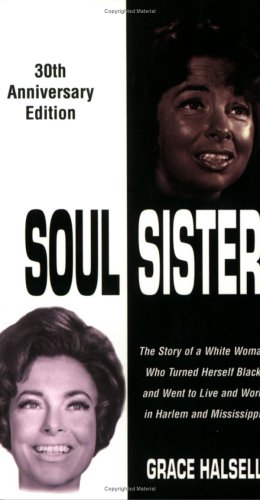Black Like Malcolm: Rewriting of Black Like Me (1961) in Soul Sister (1969)Posted in Articles, Literary/Artistic Criticism, Media Archive, Passing, United States on 2017-04-06 02:01Z by Steven |
Black Like Malcolm: Rewriting of Black Like Me (1961) in Soul Sister (1969)
Criticism
Volume 58, Number 1, Winter 2016
pages 35-58
Martha J. Cutter, Professor of English and Africana Studies
University of Connecticut
Many students and scholars of American literature and history have heard of, if not read, John Howard Griffin’s Black Like Me (1961), the autobiographical account of a white reporter who takes medication to darken his skin and pass for black in the Jim Crow South in the late 1950s in order to investigate racial prejudice. When first published, Black Like Me was lauded as a powerful text about racial injustice and employed as a standard part of some high school curricula; the work also eventually was translated into fourteen languages, hit the best-seller list in England and France, and became a multimillion-copy best seller in the United States. Black Like Me has since fallen into critical disfavor and is rarely taught in high schools, yet some of my students still know the title and can recount the plot, and contemporary African American artists such as Glenn Ligon nevertheless make overt reference to it. Very few students and scholars are familiar with Grace Halsell’s underexamined and now out-of-print memoir Soul Sister (1969), a sort of sequel to Griffin’s more famous text, in which a white female reporter undergoes the same sort of transformation to pass for black. Yet Halsell’s text does more than parallel Griffin’s process of racial transformation—it also rewrites it. Griffin has been critiqued by (among others) literary critics such as Gayle Wald for portraying himself as the white protagonist of his own civil rights drama; according to Wald, Griffin’s book “largely fails to represent black people acting as social and political agents.” Through examination of the historical context in which both texts were written—the emergence of the Civil Rights and Black Power Movements—this essay demonstrates that Halsell attempts to revise Black Like Me’s focus on a portrait of black powerlessness, pathos, and lack of voice; she also uses her narrative to articulate a plural construct of black subjectivity that cannot be contained by her own experience of blackness, by her own racial passing.
Of course, eight years separate the publication of these texts, watershed years in which black political movements became both more prominent and more radicalized, especially after the assassination of Malcolm X in 1965 and Martin Luther King Jr. in 1968. Perhaps it is no surprise, then, that Halsell (writing in 1969) inserts a political context of social activism, civil rights, and ultimately black power. Yet both reporters mobilize political context (or a lack of political context) to further certain narrative goals that in the end result in divergent approaches to the concept of black political struggle, as well as the function and meaning of white racial passing. Griffin evacuates political context to focus on a portrait of black misery; in so doing, he forwards a static, monolithic conception of black identity as one of unchanging abjection. Halsell, on the other hand, fills her text with political debate and contradictory black political positions; she thus presents a multivalent representation of black political engagement while also probing racial formation itself. Each text therefore seeks to use the genre of the white-passing narrative to motivate readers toward social change, but this change is grounded in different subject positions articulated for the reader. Griffin’s narrative attempts to move his readers to action by portraying a picture of black victimization and misery, whereas Halsell’s endeavors to revolutionize her readers by depicting her own transition into black militancy. And while Griffin’s narrative invokes a mode of social activism present from the earliest days of the Abolition Movement—pity and supplication—Halsell portrays a mode of political activism in which the oppressed seize power and become agents of social change.
Most importantly, Halsell also portrays a white failure—ultimately—to speak for African Americans or even fully comprehend their struggle; at key junctures, her text instead turns back onto itself as an exploration of white racial privilege and power. Wald has noted that racial passing, in addition to signifying a manner of being seen “according to the technologies of vision…

